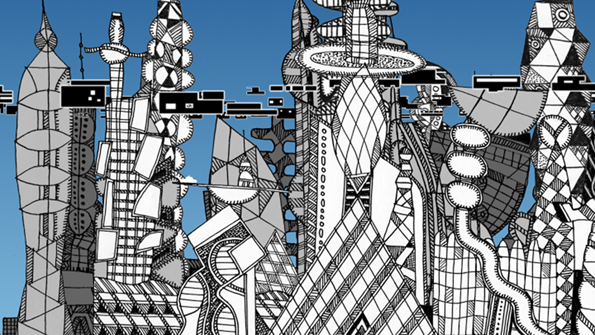Shroom: putting the anima back into animation

Institute of Ignorance
Eminent scientists are interviewed for a documentary about the future. The world’s oldest rock band releases their first single. Morris dancers and schoolchildren from the Cornish village of Lanreath invade Islington Green to protest at the social decimation of their rural idyll by urbanites hoovering up the local housing stock. These diverse scenarios all form part of the growing body of engagingly fresh animation produced by Shroom Studio.
Shroom occupies unit 5 of a building in Ellingfort Road, the first work/live block in this small alleyway off Mare Street. “This area was full of squats when we first moved here”, says Alex Hatjoullis, one of a pair of artists who started the studio in 2001. In many ways, Alex and his brother Christos epitomise ‘creative Hackney’.
Though the brothers come from an artistic family, they bring diverse skills to their enterprise. Christos has a background in theatre, dance and multimedia, while Alex started out studying product design.
Their great achievement is to make you think differently about animation. By blending it with everything from film, found images, works of fine art and children’s drawings, they create a dazzlingly eclectic mix of the quirky and the profound.
As Christos puts it, “Animation pushes the boundaries; animation is the language of dreams. You can do things with animation that you can’t do with other media”.
One of those things is to explore what exists only in the fantastic and the future, something that is impossible with traditional film.
“You can’t shoot the future; it hasn’t happened yet; it only exists in people’s minds.”
Yet the future is brought to life in their work. They made their first splash in 2002 with animation for The Luckiest Nut in the World, directed by Emily James, in which nut characters are deployed to explain the growing impact of world trade on developing countries. The film won both Oxfam America’s Global Justice Award and the Best Short Film Award at the 2003 Full Frame Documentary Film Festival.
Then came real exposure in 2004 with a Channel 4 project, Terra 2050. This is a series of four short films combining animation with video footage, still images, text and the voices of ordinary people in a richly textured and layered documentary about what the world will be like in years to come. The series was selected for numerous festivals, including one sponsored by events organisers Onedotzero, who have since included it in their ‘greatest hits’ ten-year retrospective world tour.
Alex and Christos have now risen to the top of the animation world, doing work for heavyweight establishment clients such as the BBC, Channel 4, Saatchi and the V&A, as well as for lowlier bodies such as the London Borough of Tower Hamlets and the Gateshead-based North Music Trust. Since 2001 they have undertaken approximately 100 commercial projects, including documentaries, educational films, music videos, television commercials, and installations.
Their success is due perhaps to the unique qualities that give their films a stylistic vocabulary all their own. Retro images are mixed with digital wizardry and the odd jaunty glance at classical cinema.
But by no means does this visual feast detract from the seriousness of Shroom’s productions. “We have developed a reputation as strong message makers,” says Christos, “We can communicate in a very contemporary way”. Their real passion is documentary films, especially those with an environmental slant. “What we’re doing is a new perspective on documentary film making.” They also specialise in what Christos somewhat euphemistically describes as ‘trouble-shooting’. “We’re asked to do the stuff other people won’t do.”
This includes animated takes on issues such as circumcision, sexually transmitted diseases and MRSA. Some of the most avid clients for this sort of thing are public sector organisations looking for a means of conveying messages about difficult topics. Interestingly, Alex and Christos claim to have developed some of their most innovative techniques through projects with a social angle.
So what does the future hold for these futurists? They are currently working on a film for the WWF on key species, habitat destruction and climate change. The project uses school children’s drawings of nature as a basis for the generation of animated images. They are also involved in a new series for Channel 4 on oceans, and with the BBC on multiple projects. So watch out for their distinctive style on a screen near you.
And whence the name ‘Shroom’? Nothing to do with mushrooms, apparently. Fittingly for artists, it was the visual and phonetic qualities of the word that appealed to them. As Alex puts it, “Shroom looks nice, sounds nice”. So do their films.

Humans - Pop City
